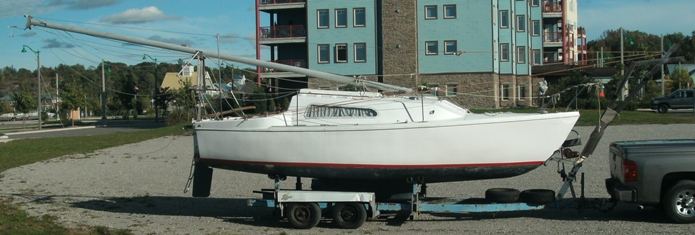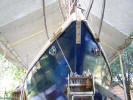To raise the Grampian 23 mast without a crane, the owner before me suggested that I just heave it up with my shoulder. I tried that a few times without any assistance, and while it worked, I was always very nervous about oh-crap moments when the mast starts moving to the side before getting it very far up. So I created an assist system. The main power of the system still comes from muscles, so, if, standing on top of the coach roof, just forward of the hatch, one cannot lift the mast at all, this will not help.
Parts:
- wooden frame made of 2x4s inserted into the square steel tube where the winch is mounted on the trailer.
- wooden frame that rests on the aft rail, with a tail that comes down and ties off to the tang for the backstay.
- 2 pulleys on the forward frame close to 5 feet in front of the front stay mounting point.
- 1 pulley that I attach to the cleat aft of the starboard winch.
- About 100 feet of rope.
When the mast is in the orientation shown in the photograph the spreaders rest on the top of the aft frame, the foot of the mast engages with the step, and the wire ropes can all be laid out. The rear frame stay on the boat and the mast ties to the top of it for storage, allowing me to open the pop top and access the interior with the mast "down". The aft frame also holds the mast up at enough of an angle to make getting started at lifting the mast much easier. The rope goes from the forestay through a pulley at the front, back to the winch, taking one turn, through the pulley and back forward to the second forward pulley and back to my hand, as I stand on the aftmost part of the cabin top. I lift the mast and take up slack in the lines, using the winch only as a lock to prevent the line from easily pulling back. With the line to the forestay snug, the mast is under better control. Once the mast is shoulder high, I pull harder on the rope and walk forward toward the mast step. The combination of pull at the top of the mast and my shoulder against the mast make the shoulder-high to all the way up part of the motion much easier, and more importantly, in control. The tension on the rope holds the mast engaged with the step. At all times a large amount of the force comes from my shoulder, so the mast is not putting too much forward load on the step. At times, one of the wire ropes will snag on something 20 degrees from vertical. In this case, I take my hand rope, wrap it around the mast twice about shoulder level -- above the jib pole ring on the front of the mast -- and tie a knot. Between the pull on the forestay and the pull of the rope at shoulder level, the mast is rock solid in this orientation. I can walk away from it. I then go back and clear the wire ropes, come back to the mast and put it up all the way. Once up all the way, I have a knot on the forestay segment of rope that will not go into the first front pulley. This leaves the forestay a little slack, and the hand end of the rope firm. I again tie the hand end of the rope around the mast, the knot jammed in the pulley holding the other end of the rope for me. I go forward, unhook the forestay from the loop on the end of the rope and attach it to its attachment on the bow. I then untie the rope from the mast and the aft cleat and coil the rope and hang it on the forward frame, off the boat. The boat is ready to launch.
To unstep the mast, I put the pulley back by the starboard winch, with the same rope wrapped around the winch in the same direction. I tie the end of the hand rope to the mast, remove the forestay and attach it to its end of the rope. I then grab the hand rope and rock the mast back gently to pull the forestay tight. When my mast raising rope was new, I could feed rope at the hand end, and it would slide on the winch back and allow the mast to rest backward on my shoulder. Now I have to grab the first rope leading back to the pulley and feed there. I would then walk back, forestay pulling the rope around the winch, mast resting back on my shoulder. I lower it slowly and set it down on the rear frame. From about 45 degrees down, I keep the tension on the forestay low and carry most of the weight on my shoulder.
Most importantly, above about 45 degrees, the mast is always under control and I can stop the process by tying off the hand rope on the mast at shoulder level. Below 45 degrees more and more of the weight is on my shoulder, but, the rope adds control. (Matt Malone, M.A.Sc. P.Eng) Back
See also Grampian 26 FAQ


